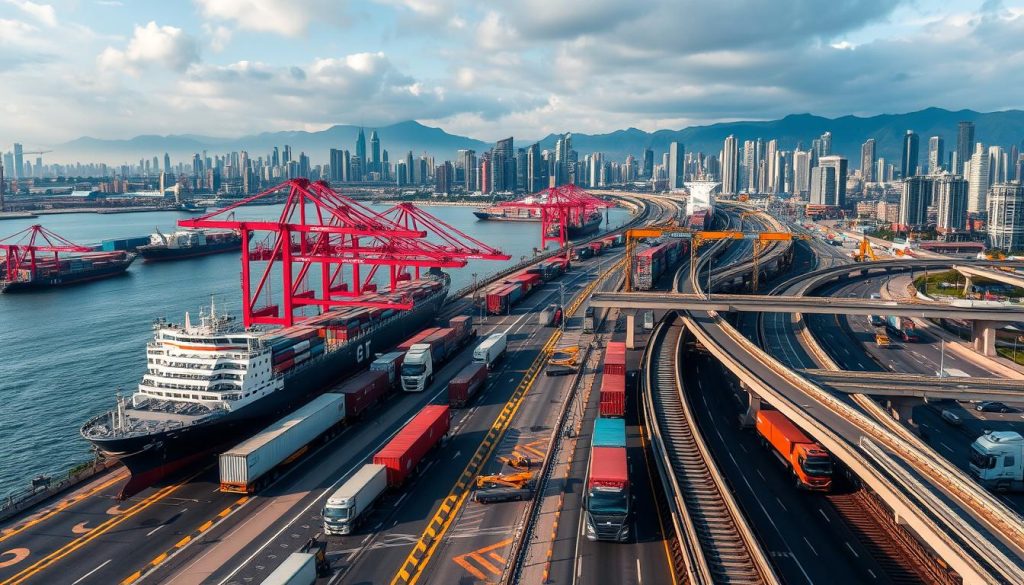Asia is becoming a key focus for the world, especially for transport and logistics. The region is expected to grow fast, making it crucial for the global economy. The Asian Development Bank and World Bank have shown big investments in Asia’s transport and logistics.
These investments highlight a promising future for the sector. They show a landscape full of opportunities for innovation and growth.
The Rapid Growth of Asia’s Transport Sector

The transport sector in Asia is growing fast. This is due to more people, cities getting bigger, and more demand from consumers. The numbers show a big increase in both goods moved and people carried.
India and Vietnam are leading the way in this growth. They have seen big increases in transport each year. Several things help this growth:
- Urbanisation, leading to higher mobility needs.
- Rising income levels, which enhance consumer purchasing power.
- Investments in infrastructure that facilitate transport improvements.
- The expansion of e-commerce, increasing demand for logistics services.
Government data shows more goods being moved across borders. This leads to more development in the logistics sector. Better infrastructure and transport networks make the area more appealing for logistics investments.
Investments Driving Transport Infrastructure Development

Big investments are changing Asia’s transport sector. Governments and private groups see the need for better logistics funding. This is key for growth and connecting the region.
Work on railways, roads, airports, and seaports is growing. Public-private partnerships are key. Asia’s funding is crucial for these big projects, meeting trade and travel needs.
- China’s Belt and Road Initiative is a big example, spending billions on projects.
- India and Indonesia are investing in their transport systems with state funds and loans.
- The private sector is getting involved, offering new ways to fund projects without government costs.
The Asian Development Bank says Asia needs trillions for infrastructure. Long-term plans and teamwork are vital. Good funding for logistics is essential for Asia’s economic growth.
Emerging Trends in Logistics in Asia
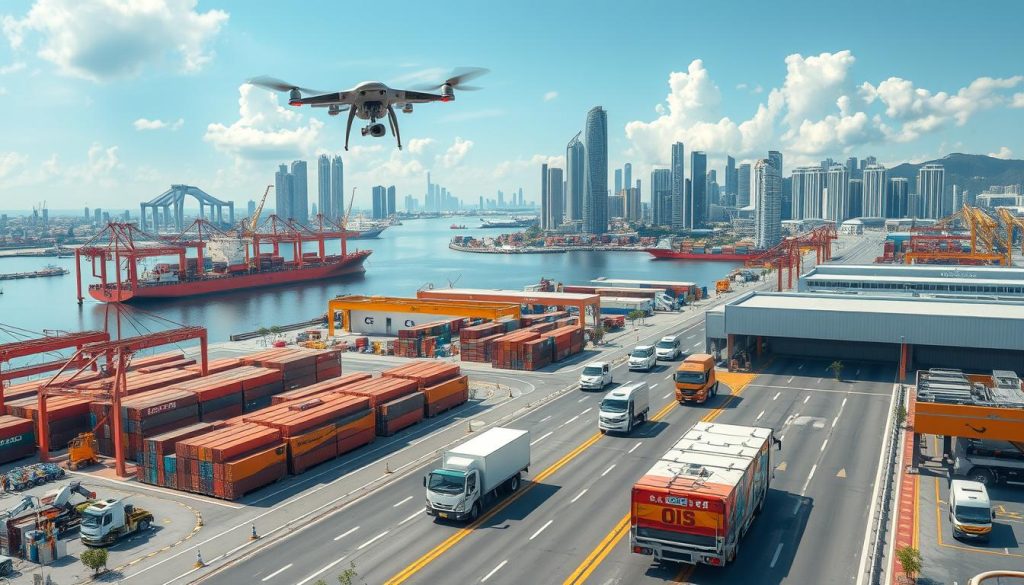
Recent logistics trends in Asia show big steps forward. Automated tech is changing how things work, making them better and less prone to mistakes. Companies use data to understand their supply chains, helping them make quick, smart choices.
Blockchain technology is also becoming key. It makes logistics more open and honest. This lets companies keep track of goods, meeting customer needs for safety and trust.
Global supply chains are playing a big role too. Companies are looking for future logistics innovation to handle the challenges of international trade. Digital changes are at the heart of this, pushing firms to improve their logistics to meet new customer needs.
These logistics industry changes boost efficiency and quality of service. As companies embrace these trends, they stay ahead in the fast-changing market.
Transportation and Logistics Business Opportunities in Asia
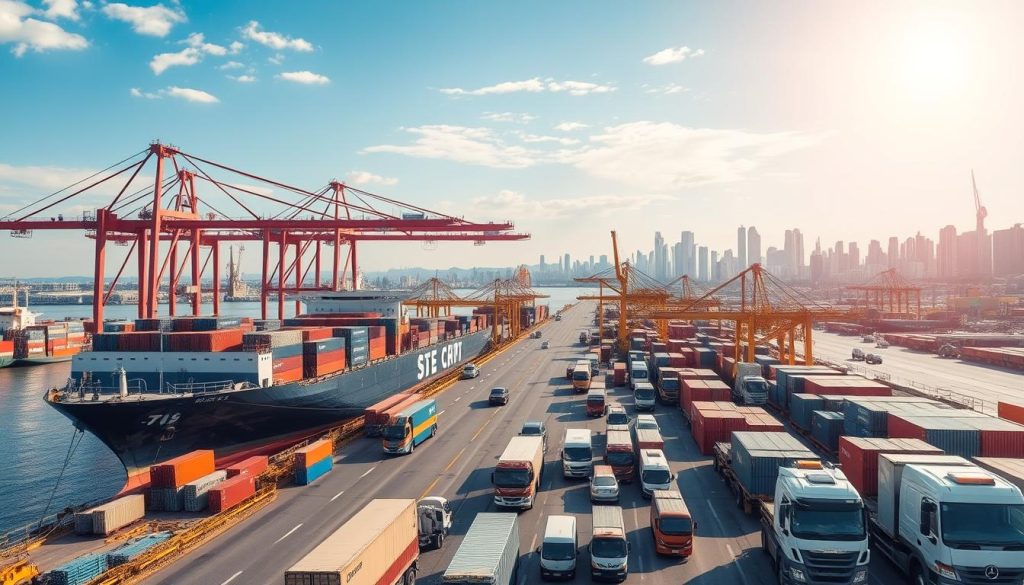
The logistics business in Asia is booming. This is thanks to growing demand in areas like Southeast Asia, India, and China. These markets are full of chances for new investments and creative ideas.
Companies can now offer special solutions for these fast-changing regions. This is a big opportunity for growth.
Key Markets and Regions to Watch
Southeast Asia is a top spot for logistics growth. Its diverse economies and big trade activities make it attractive. India is also growing fast in logistics, thanks to better trade policies and new infrastructure.
China leads in using technology in logistics. This makes its services more efficient and reliable.
- Southeast Asia: Key trading hubs include Singapore, Malaysia, and Indonesia.
- India: Rapid urbanisation and increasing internet penetration fuel growth.
- China: A frontrunner in adopting technology-driven logistics solutions.
Innovative Start-ups Reshaping the Landscape
New logistics start-ups are changing Asia’s logistics scene. They use the latest tech, like drones and automated warehouses. They also use data to make operations better.
These start-ups make services more efficient and customer satisfaction higher. They are pushing traditional logistics to adapt to new needs. This is creating new chances in Asia’s logistics world.
The Role of Technology in Modern Logistics
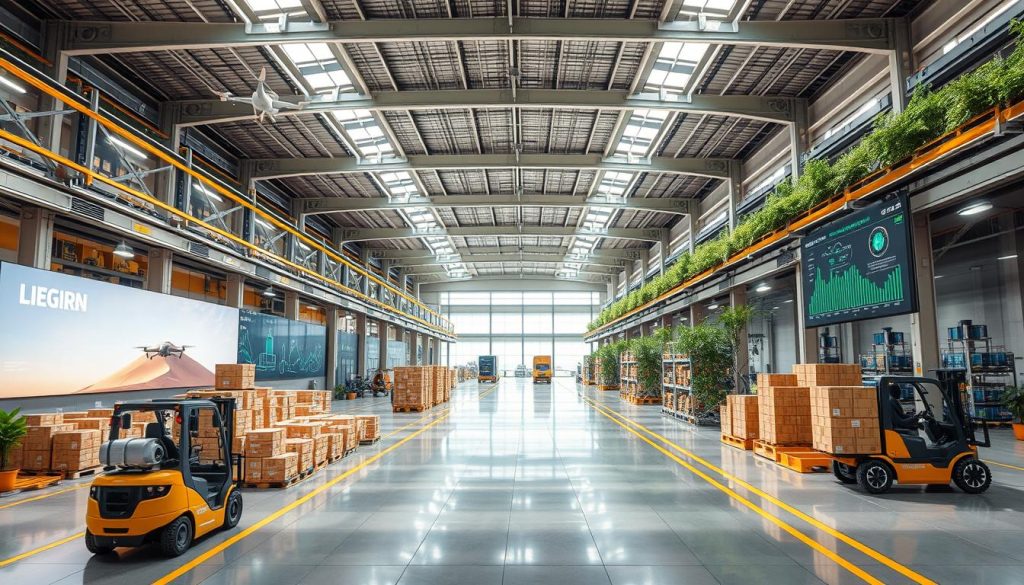
Technology is changing the logistics industry in big ways. It brings new solutions that make things more efficient and cheaper. With digital tools, companies can manage their supply chains better from start to finish.
The Internet of Things (IoT) has changed logistics a lot. It lets companies track their assets in real-time. This gives them important information for making quick decisions, making the supply chain more flexible.
Artificial Intelligence (AI) is also making a big difference. AI looks at lots of data to predict what customers might want. This helps companies keep up with demand without spending too much.
Technology’s impact is different for every company. Smaller businesses are using digital tools to keep up with bigger ones. Many are investing in new tech to make their operations smoother.
Challenges Facing the Transport and Logistics Sector
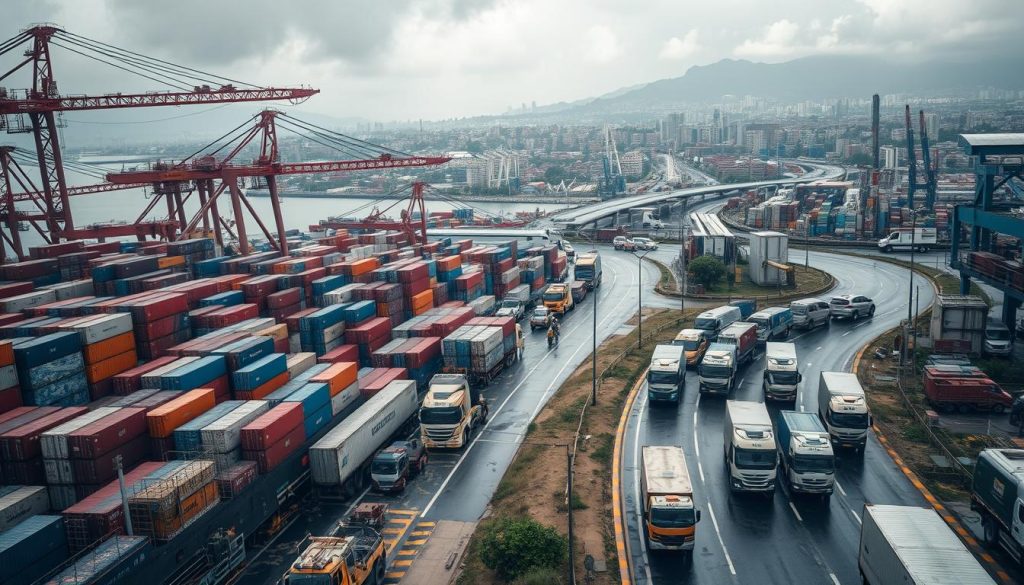
The transport and logistics sector in Asia faces many challenges. These come from different transport rules in Asia, making cross-border logistics hard. Also, there’s not enough space for transport and a big need for logistics services. Traffic jams in cities make things even harder.
Regulatory Hurdles
Transport rules in Asia are a big problem. Each country has its own laws, causing confusion. This makes it hard for businesses to move goods smoothly across borders.
Capacity Constraints
There’s not enough room for transport in the region. Bad infrastructure and a lack of skilled workers add to the problem. Traffic jams in cities make things worse, making it hard to meet growing demand.
Government Initiatives Supporting Logistic Growth

Government logistics initiatives are key to improving the logistics scene in Asia. They aim to support the logistics industry by creating a better environment. This is done through various infrastructure policies that encourage growth and innovation.
One important strategy is promoting public-private partnerships. These partnerships help by bringing in private sector skills and money. They improve infrastructure and make operations more efficient.
Investing in research for logistics technology is also a focus. Governments see how important tech is for better service and efficiency. They have programs to help bring new technology into the logistics sector.
It’s also crucial to make regulatory processes easier. By cutting down on red tape and making rules simpler, governments make the transport sector more appealing. This attracts both local and international businesses.
- Public-private partnerships in logistics.
- Investment in logistics technology research and development.
- Regulatory streamlining to ease transport operations.
International Trade and Its Impact on Transport Facilities
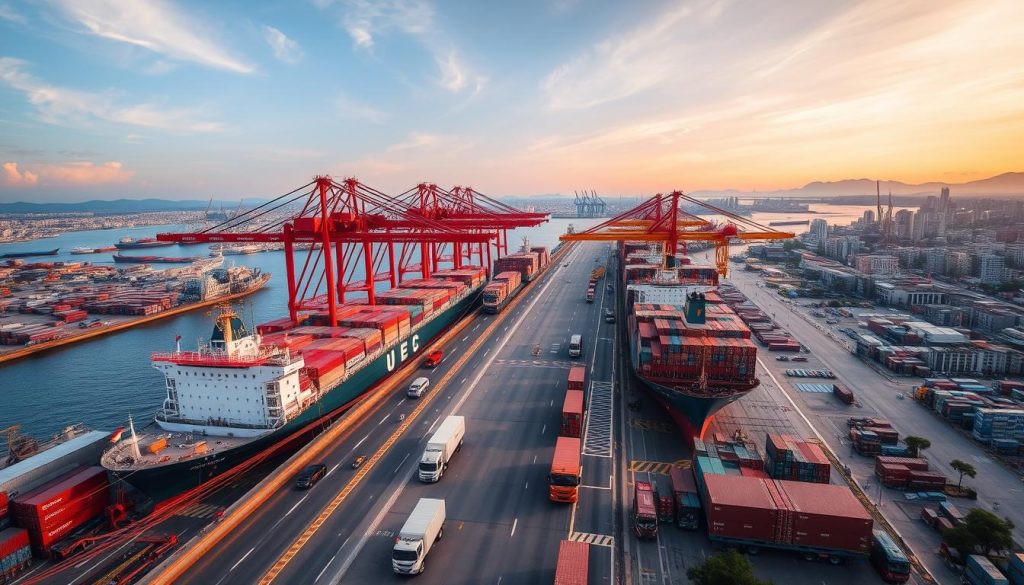
International trade is key to improving transport facilities in Asia. Trade agreements boost infrastructure and logistics services. The growth of global supply chains and local networks drives transport facility development.
Reports from the World Trade Organisation show how trade agreements shape sectors like transport. These agreements make customs processes smoother, speeding up goods movement. Countries in these partnerships see big improvements in their transport facilities, meeting international trade needs.
Studies link better transport infrastructure to more international trade. Investing in logistics systems prepares countries for future growth. This is due to expanding trade relationships.
- Enhanced infrastructure supports increased trade volumes.
- Modernised facilities lead to more efficient logistics operations.
- Collaboration among countries fosters shared trade benefits.
Green Logistics: Sustainable Practices in Asia
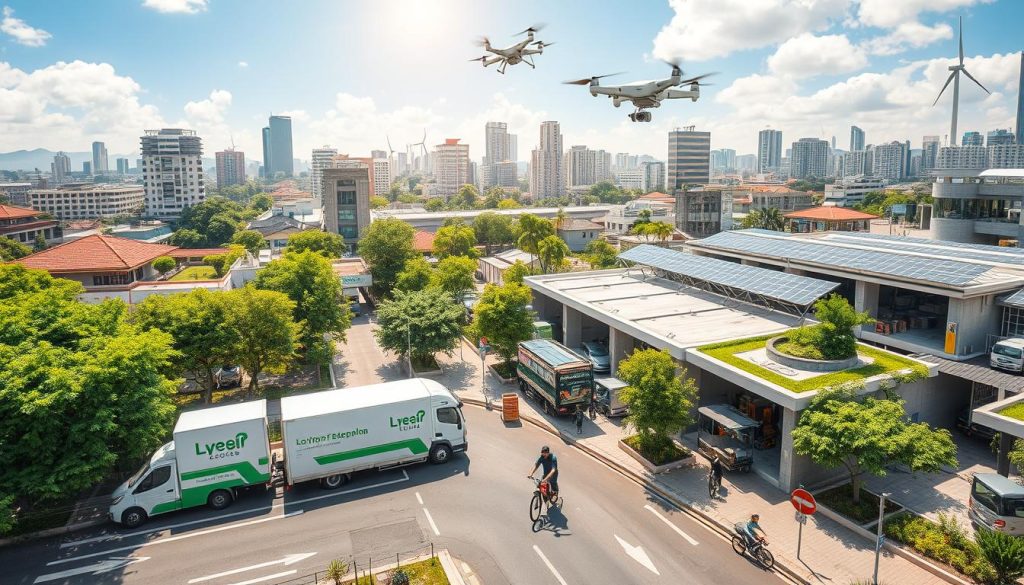
The logistics sector in Asia is moving towards sustainable practices. This change shows a growing commitment to green logistics. Companies are looking into new ways to cut down on carbon emissions and improve efficiency.
Big companies are adopting eco-friendly logistics. They focus on operations that are good for the environment. This shows how important it is to be environmentally responsible.
Some key changes include:
- Using electric vehicles for transport
- Building green warehouses to save energy
- Creating carbon-neutral transport options to meet rules
Companies like DHL and Maersk have shown success with these green practices. The need for eco-friendly logistics comes from caring for the environment and meeting customer expectations. As more businesses go green, the whole logistics system in Asia will benefit.
The Importance of Last-Mile Delivery Solutions
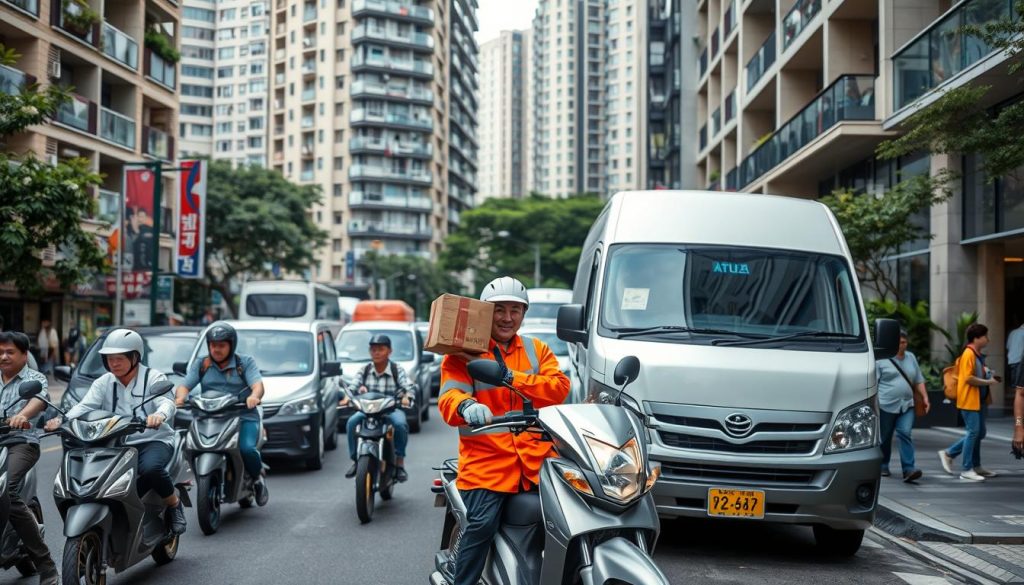
Last-mile delivery is key in the logistics chain, being the final step to get goods to customers. With more people moving to cities, urban logistics face big challenges. These include more traffic, shorter delivery times, and customers wanting their goods fast.
Urbanisation and Its Effects on Last-Mile Logistics
Urbanisation greatly affects last-mile delivery. As cities grow, so does the need for better delivery solutions. Customers want their items quickly, putting pressure on delivery services to find new ways to work.
To tackle these issues, companies are trying different approaches. These include:
- Crowd-sourced delivery models that use local people for deliveries.
- Local fulfilment centres to make delivery routes more efficient.
- Automated vehicles and drones to improve delivery speed.
By using these strategies, businesses can handle urban logistics better. They can make last-mile delivery more effective. As cities keep changing, finding good last-mile solutions is key to success.
Understanding E-commerce’s Role in Logistics Growth

The growth of e-commerce in Asia has changed the logistics scene a lot. Online shopping now needs better logistics solutions to meet customer needs. This change affects many parts of logistics, like storage, managing stock, and getting goods to customers.
With more people shopping online, logistics teams must work faster to fill orders. The rise of e-commerce has brought changes in several areas:
- Warehousing: Warehouses need to be in the right places to speed up deliveries to busy cities.
- Inventory Management: It’s important to keep track of stock levels in real-time to avoid running out.
- Delivery Services: With more direct-to-consumer deliveries, there’s a need for flexible and quick delivery options.
Reports show that online shopping growth is leading to more investment in tech and infrastructure. Companies are looking at new ways to use technology, like robots and AI, in their warehouses and delivery systems.
Building a Skilled Workforce for the Future
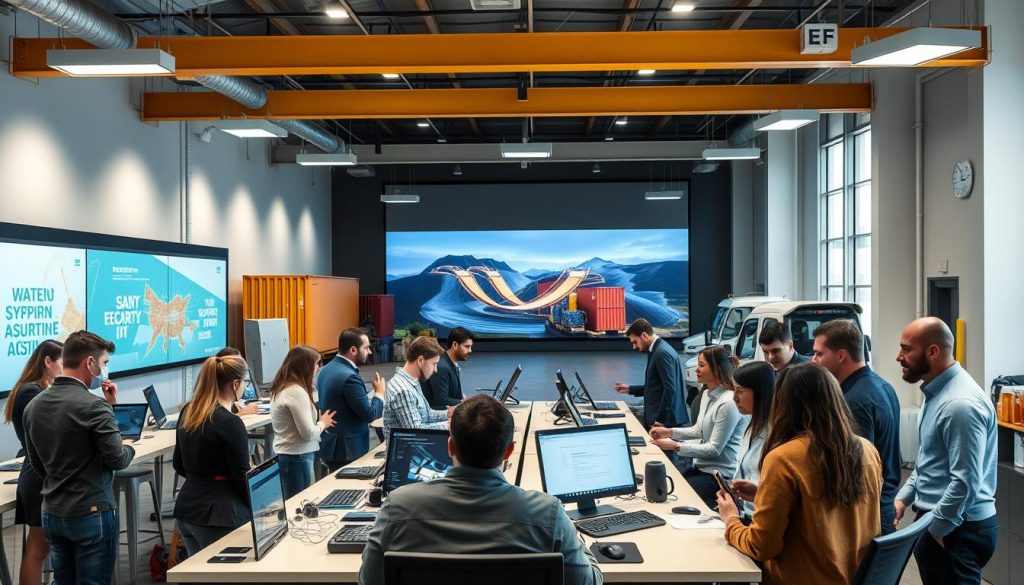
The logistics sector is changing fast, thanks to new tech and shifting markets. To stay ahead, having a skilled team is key. This means using vocational training, teaming up with schools, and getting industry certifications. These steps help build a workforce ready for the industry’s new challenges.
Training and Development Initiatives
Many training programs have started to fill the skills gap in logistics. These programs aim to improve workers’ skills with both hands-on and book learning. Investing in vocational training is crucial for finding skilled workers in logistics. Companies are now seeing the value in ongoing learning.
- Working with local colleges and universities to create special training programs.
- Industry certification schemes that prove skills and boost job chances.
- On-the-job training that gives real experience in logistics.
The International Labour Organisation says training is key to solving skills shortages. Developing the logistics workforce is not just about getting people ready for jobs. It’s also about growing professionals within companies. As logistics grows, investing in training will be crucial for the industry’s future.
Strategic Alliances and Partnerships in Asia’s Logistics
The logistics scene in Asia is changing fast. This is thanks to strategic partnerships that boost operations and reach. Partnerships between logistics firms and tech companies are key. They bring innovation and better service delivery.
Many examples show how alliances in Asia lead to better efficiency and happier customers. These partnerships help share resources and bring in new tech. This means logistics companies can meet the needs of growing international trade.
Also, working with governments is vital for Asia’s logistics future. These partnerships push for better infrastructure and rules. As companies team up, Asia’s logistics industry is set for big growth. This will create a strong ecosystem for everyone involved.

